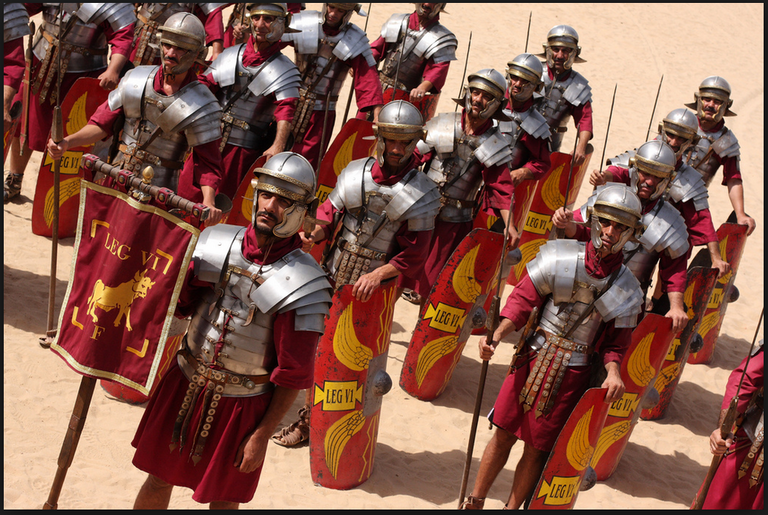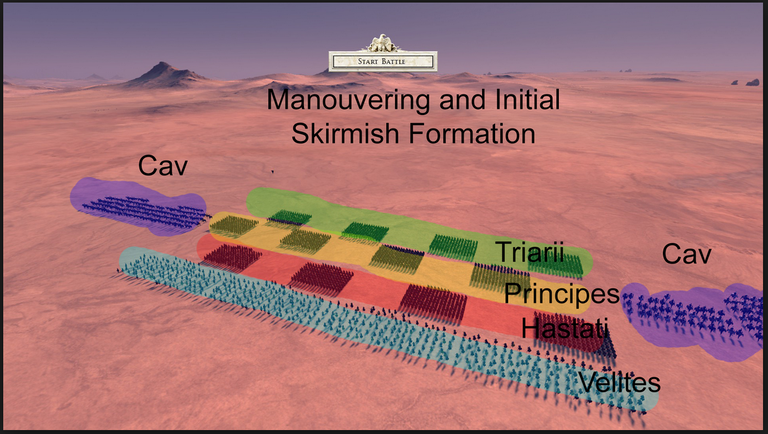In my previous post, I spoke about the evolution of the Roman army from the early Phalanx to the later Cohorts. The most complex army composition that Rome had, came in the time of the maniple. This unit was the answer to the failing tactics of the Phalanx in the mountainous terrain of Italy. Not yet a self-contained unit, maniples would still partition the armies in order of experience...
Hastatii
An army would consist of a number of maniples that would be a lot more maneuvrable on the battlefield and the rank of these maniples would determine the position held on the battlefield. The Hastatii would make up the front line of the Roman army and the soldiers would be the least experienced on the battlefield. This had a dual purpose, to build up the experience of the army as well as keep the more experienced troops in reserve and out of immediate danger.
Hastatii would be equipped with a sword and a shield as well as decent armour making them quite formidable in the formations that Rome was using, namely the checkerboard formation. The size of the maniple would also allow for these units to be quickly moved around the battlefield as needed. With the sword and shield, Roman soldiers were all equipped with 2 javelins effectively turning every Roman soldier into a skirmisher (ranged unit). These javelins were used with deadly efficiency to slow an enemy charge or to soften up the formation of the enemy before a Roman charge. Since Rome relied primarily on heavy infantry, the enemy would usually be a lot faster than the Romans, especially in a rout. This made chasing down the enemy difficult so javelins would be very useful while the enemy was retreating
Principe
The second line would be comprised of Principe units. These units were made up of more experienced and battle-hardened troops with slightly better equipment, also a sword, shield and javelins. The primary goal of the Principes in the second line would be a relief for the Hastatii. Once contact with the enemy commenced, the Principe would stand back awaiting the order to rush in and replace the Hastatii. This was a very effective strategy as the units would alternate allowing for the other unit to rest up. The Principes and Hastatii would swap back and forth as needed in order to let the fatigued troops rest.
Trirarii
The third and final line would consist of the Triarii. These units were considered the absolute best! They were the most experienced and well-equipped troops on the field, retaining some of the battle tactics of the Phalanx. As well as being equipped with sword and shield, Triarii would carry spears and javelins making them the perfect defensive troop. In a perfect world, the Triarii would not ever engage the enemy troops as the Hastatii and Principes would do most, if not all of the grunt work. As the third line, the Triarii were ordered to always maintain their position at the back of the army where they would act as a last resort should the battle go awry.
The Romans had a famous saying concerning the Triarii since they were so rarely used. The saying "It has come to the Triarii" was used to indicate the desperation of a situation as the Triarii were only ever used as a last resort. Naturally, these experienced elites would often bristle with the lack of 'action' on the battlefield and many commanders would go so far as to order the Triarii to sit down on the battlefield to prevent them from rushing forward to join the fight.
Miscellaneous troops
The Romans were loath to rely on cavalry for anything other than scouting but Rome would often hire cavalry mercenaries when they were needed. As well as these mercenaries, rome would also have a large camp following as the baggage train to support the troops would need to be quite large. In an effort to put these extra people to use, they would be trained in the use of slings and bows adding an extra defensive attribute to the army.
Picture taken from the game - Total War: Rome 2
To be continued...
Roman army strucure still had to to face many changes and tommorow I would like to discuss the make-up and possibly command structure of a Roman Legion.




Very good article my friend.
Bookmark worthy
Upvoted
I like your post. I have followed you. Please follow me
This post recieved an upvote from minnowpond. If you would like to recieve upvotes from minnowpond on all your posts, simply FOLLOW @minnowpond
I like this post and the content I regularly publish, I love everything about Rome. Thanks for sharing!
Congratulations! This post has been upvoted from the communal account, @minnowsupport, by DracoSalieri from the Minnow Support Project. It's a witness project run by aggroed, ausbitbank, teamsteem, theprophet0, someguy123, neoxian, followbtcnews/crimsonclad, and netuoso. The goal is to help Steemit grow by supporting Minnows and creating a social network. Please find us in the Peace, Abundance, and Liberty Network (PALnet) Discord Channel. It's a completely public and open space to all members of the Steemit community who voluntarily choose to be there.